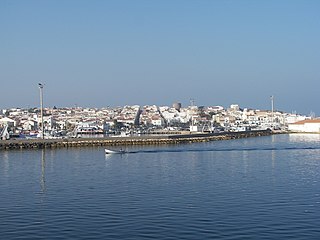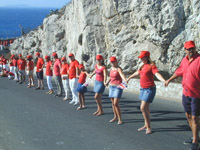
Demographic features of the population of Gibraltar include ethnicity, education level, health of the populace, economic status, religious affiliations and other aspects.

Liguria is a region of north-western Italy; its capital is Genoa. Its territory is crossed by the Alps and the Apennines mountain range and is roughly coextensive with the former territory of the Republic of Genoa. Liguria is bordered by France to the west, Piedmont to the north, and Emilia-Romagna and Tuscany to the east. It rests on the Ligurian Sea, and has a population of 1,557,533. The region is part of the Alps–Mediterranean Euroregion.

Llanito or Yanito is a form of Andalusian Spanish heavily laced with words from English and other languages, such as Ligurian; it is spoken in the British overseas territory of Gibraltar. It is commonly marked by a great deal of code switching between Andalusian Spanish and British English and by the use of Anglicisms and loanwords from other Mediterranean languages and dialects.

The culture of Gibraltar reflects Gibraltarians' diverse origins. While there are Spanish and British influences, a result of the territory's status as a British overseas territory and its proximity to Spain, the ethnic origins of most Gibraltarians are a mix of Andalusian Spaniards, Genoese, Maltese, Portuguese and British. The main religion is Christianity, the majority group being the Roman Catholic Church, then the Church of England. There is a long established Sephardic Jewish community, a number of Hindu Indians and a Moroccan Muslim population. Gibraltarians of Genoese origin came to The Rock in the 18th century, with the Maltese and Portuguese following in the 19th century, coming to work and trade in the British military base. Spanish Andalusian origins are the result of generations of intermarriage with inhabitants of surrounding towns.

Focaccia is a flat leavened oven-baked Italian bread. In some contemporary places, such as Rome, it is a style of pizza, also called pizza bianca. Focaccia may be served as a side dish or as sandwich bread and it may be round, rectangular, or square shape.

Farinata, socca, torta di ceci, or cecina is a type of thin, unleavened pancake or crêpe made from chickpea flour. It originated in Italy and later became a typical food of the Ligurian Sea coast, from Nice to Sardinia and Elba islands. It is also typical in Gibraltar, where it is called calentita.

Catalan Bay is a bay and fishing village in Gibraltar, on the eastern side of The Rock away from Westside.

The Gallo-Italic, Gallo-Italian, Gallo-Cisalpine or simply Cisalpine languages constitute the majority of the Romance languages of northern Italy: Piedmontese, Lombard, Emilian, Ligurian, and Romagnol. In central Italy they are spoken in the northern Marches ; in southern Italy in some language islands in Basilicata and Sicily.

Ligurian or Genoese is a Gallo-Italic language spoken primarily in the territories of the former Republic of Genoa, now comprising the area of Liguria in Northern Italy, parts of the Mediterranean coastal zone of France, Monaco, the village of Bonifacio in Corsica, and in the villages of Carloforte on San Pietro Island and Calasetta on Sant'Antioco Island off the coast of southwestern Sardinia. It is part of the Gallo-Italic and Western Romance dialect continuum. Although part of Gallo-Italic, it exhibits several features of the Italo-Romance group of central and southern Italy. Zeneize, spoken in Genoa, the capital of Liguria, is the language's prestige dialect on which the standard is based.
Genoese, locally called zeneise or zeneize, is the prestige dialect of Ligurian, spoken in and around the Italian city of Genoa, the capital of Liguria, in Northern Italy.

Calasetta is a small town and comune located on the island of Sant'Antioco, off the Southwestern coast of Sardinia, Italy.

Sassello is a comune (municipality) in the Province of Savona in the Italian region Liguria, located about 58 kilometres (36 mi) west of Genoa and about 26 kilometres (16 mi) north of Savona in the northern side of the Ligurian Apennines. It is the birthplace of Blessed Chiara Badano.

The sole official language of Gibraltar, a British overseas territory, is English, which is used by the Government and in schools. The eponymous Gibraltarian English accent is spoken in the territory.

Gibraltarian cuisine is the result of a long relationship between the people of Spanish Andalusia and those of Great Britain, as well as the many foreigners who have made Gibraltar their home over the past three centuries. These influences include those of the culinary traditions of Malta, Genoa, and Portugal. This marriage of tastes has produced in Gibraltar an eclectic mix of Mediterranean and British cuisines.

Gibraltarians are an ethnic group native to Gibraltar, a British overseas territory located near the southernmost tip of the Iberian Peninsula at the entrance to the Mediterranean Sea.

Kaiane Loise Aldorino Lopez, GMH is a Gibraltarian politician, former Mayor of Gibraltar and beauty queen who won Miss World 2009. From 2017 to 2019, she held the ceremonial position of Mayor of Gibraltar, after previously serving as Deputy Mayor since 2014.

Intemelio is a Ligurian dialect spoken historically from the Principality of Monaco to the Italian province of Imperia.

John Mackintosh Square is a main square in the British overseas territory of Gibraltar. It has been the centre of city life since the 14th century and takes its name from John Mackintosh, a local philanthropist. Notable buildings on John Mackintosh Square include the Parliament Building and the City Hall.
Fiorenzo Toso was an Italian academic, linguist, and dialectologist.






















